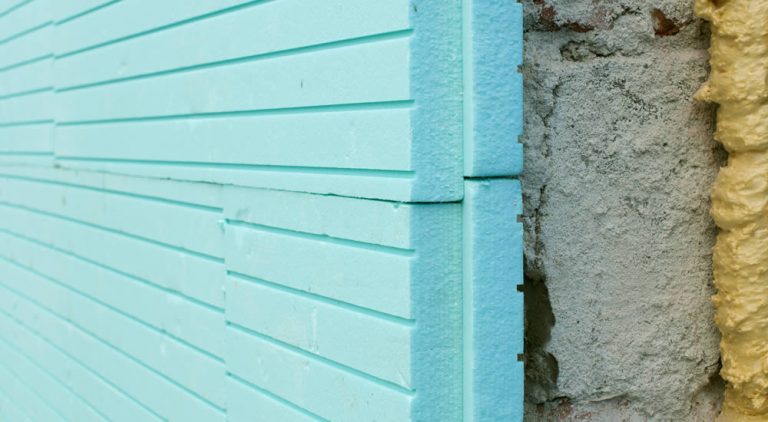Picture this: you’re ready for a good night’s sleep, but the construction site across the street is working at full capacity and you can’t catch a wink. You purchase “soundproofing” foam acoustical panels online hoping they’ll dampen the noise and make it easier to sleep only to find that they offer no relief from the relentless construction noise.
Talk about “the city that never sleeps.”
Why didn’t they work? Your acoustical tiles may have been labeled as “soundproofing tiles”, but a more accurate term would be “sound-absorbing tiles”.
While both soundproofing and sound-absorbing materials will help control noise, “soundproofing” and “sound-absorbing” are not the same thing. Both types of materials have unique characteristics that make them ideal for different uses—generally, soundproofing materials are heavier with greater mass so they block sound entirely, while sound-absorbing materials are soft and porous to trap sound waves and prevent echoes.
Many so-called “soundproofing” products and materials are technically sound absorbers, and many others are generically labeled as “noise reduction” or “acoustical treatment” materials. Unless you’re an expert in soundproofing and acoustics, knowing what material you need to control sound and noise in your space can quickly become confusing.
So how do you know which material is right for you? Read this guide to learn more about the difference between sound-absorbing and soundproofing materials and determine which you need to manage noise like traffic, car alarms, and sirens.
What are Sound-absorbing Materials?
Sound-absorbing materials are typically soft and fluffy in texture, and are mainly used to improve the acoustics within a room. These materials work by absorbing sound waves that bounce off hard surfaces like walls and ceilings in order to reduce reverberations that cause poor acoustics, background noise, and echoes.
Sound-absorbing materials can drastically improve sound quality within enclosed spaces, but they won’t stop noise from entering or exiting a space. So while sound absorbers will help reduce echo in large spaces, they won’t keep construction noise out of your bedroom—if you’re looking for a way to block outside noise or quiet your noisy neighbors, you need soundproofing materials.
Examples of common sound-absorbing materials
- Acoustical tiles or foam panels: Foam panels create open cells across their surface area that capture sound waves as they penetrate the foam, acting to absorb the sound.
- Soundproof blankets: These blankets are thicker, denser, and sturdier than other blankets, with a soft and porous texture that enables them to catch sound waves and stop them from bouncing off hard surfaces.
- Soundproof window curtains: Available in many styles to suit your space, soundproof curtains are thicker and denser than regular curtains with a layer of high-density black yarn in the middle to absorb sounds.
- Soundproof wallpaper: Soundproof wallpaper is not technically wallpaper—it’s actually a closed-cell polyethylene foam with vibration damping and insulating properties.
Read our guide to soundproofing materials to learn more about these sound-absorbing methods.
When to use sound-absorbing materials
- If your space suffers from echo, reverberation, or poor speech intelligibility
- In music and recording studios, conference rooms, lecture halls, gymnasia, and other large spaces
What are Soundproofing Materials?
Unlike sound absorbers, soundproofing materials are specially designed to block sound from entering or escaping a room at all.
They do this by adhering to four principles:
1. Mass
Adding mass in the form of solid materials that are heavy and/or thick is one of the most effective ways to block sound and reduce noise transfer, particularly for airborne sounds like voices. Examples: Additional layers of drywall, mass-loaded vinyl.
2. Damping
Damping is achieved using special compounds that convert energy into heat. In order to be effective, the damping compound must be applied between two stiff panels, such as drywall or plywood, which are then screwed together. Damping is particularly effective for reducing low-frequency noise. Examples: Green Glue, some silicone caulking.
3. Decoupling
Decoupling introduces gaps into the internal structure of a building. These gaps make it much easier to interrupt sound vibrations by forcing them to vibrate uselessly against the decoupling materials rather than transferring through the wall, floor, or ceiling. Decoupling is ideal for blocking sounds that transfer through the structure of a building, such as impact noises. Examples: Resilient channels.
NOTE: Poorly executed decoupling may actually worsen low-frequency noise by effectively creating a “room within a room”.
4. Absorption
Soundproofing and sound-absorbing materials are often used together to achieve the maximum impact—for example, installing acoustical tiles between two layers of drywall will add mass that will help soundproof a space, while the tiles will absorb any sound waves that do pass through the drywall. Examples include: Acoustic tiles, soft furniture.
Sometimes referred to as “sound insulating” materials, soundproofing products are typically installed inside walls or ceilings as part of the construction of a building. As a result, it’s often difficult to soundproof a space after construction is complete. However, there are some effective and non-invasive soundproofing tactics you can employ to control noise after construction, such as installing soundproof interior windows.
Examples of common soundproofing materials
- Mass-loaded vinyl: Considered one of the most effective sound-blocking materials, mass-loaded vinyl is a very thin, dense, flexible membrane that efficiently adds mass to walls, floors, and ceilings without adding bulk. Quiet Rock—a special type of sheetrock that can be added to your walls after construction—is similar to mass-loaded vinyl.
- Resilient channels: Resilient channels are thin, flexible pieces of sheet metal that decouple drywall from the internal structure of a building to reduce noise transfer by making gaps in the path sound waves travel.
- Damping compound: Technically not a sound blocker or a sound absorber, damping compound acts as a sound dampener by converting sound waves into heat.
- Custom-fitted soundproof windows: Soundproof windows are a second set of windows that work in conjunction with your existing windows to seal out outside noise, drafts, and dirt. The best soundproof windows are custom-fitted to ensure a tight seal.
Read our guide to soundproofing materials to learn more about these products.
Unlike companies that use an average measurement to keep costs low, every Cityproof Citiwindow® is custom-fitted and manufactured to create a tight seal that eliminates gaps and ensures maximum noise reduction. In addition to creating a perfectly sealed sound buffer zone, Cityproof uses laminated glass which consists of two layers of glass with a special interlayer of polyvinyl butryal sandwiched between them to seal out over 90% of exterior noise. This interlayer also makes Citiwindows shatterproof and 99% UV resistant.
Learn more about why you should choose Cityproof for your noise-reducing windows.
When to use soundproofing materials
- During initial construction or renovation. Some soundproofing materials, including mass-loaded vinyl, Quiet Rock, and soundproof windows can be added after construction, but it is easier and more economical to install these materials during initial construction or renovation.
- If you’re suffering from low frequency noise or impact noise incursion
- To reduce noise transfer between rooms and exterior noise creeping in through walls or cracks around windows and doors, especially if it inhibits sleep, relaxation, or the day-to-day operations of your home or business.
Do I Need Soundproofing or Sound-absorbing Materials?
Whether you need soundproofing or sound-absorbing materials depends on your goals for your space. Start by asking yourself these questions:
- What type of noise are you trying to control? Take a moment to identify the noise and its source.
- What are your goals? Do you want to improve the quality of sound in the room, or do you want to keep sound out of the room?
- What is the purpose of the room? Managing sound in music or recording studios, conference rooms, and lecture halls will call for different materials than reducing noise in your bedroom or living room, for example.
- What are the dimensions of the hard surfaces in the room? This will impact the cost of soundproofing your space.
- Do aesthetics matter? If so, what type of look or finish are you seeking?
Once you’ve determined what kind of material you need, a simple way to tell whether you’re looking at a soundproofing or a sound-absorbing material is to check the rating scale used to measure its efficacy:
- The effectiveness of soundproofing materials is measured using a Sound Transmission Class (STC) number, Transmission Loss (TL) curve, or a weighted sound reduction index value. These measurements indicate that the product was tested as a sound-blocking material.
- Sound-absorbing materials are measured using a Noise Reduction Coefficient (NRC) or weighted sound absorption coefficient.
Soundproofing vs. Sound Absorption Comparison Chart
| Soundproofing | Sound-absorbing |
|
|---|---|---|
| Mass | Typically heavier with greater mass | Typically lighter, porous materials |
| Purpose | Blocking sound from entering a space | Absorbing sound waves within a space |
| When to use | Reducing noise from loud neighbors, street and construction noise, or other sources of noise pollution | If your space suffers from echo, reverberation, or poor sound quality |
| Measures of efficacy | Sound Transmission Class (STC), Transmission Loss (TC) curve, or weighted sound reduction index value | Noise Reduction Coefficient (NRC) or weighted sound absorption coefficient |
| Examples | Soundproof interior windows, mass-loaded vinyl, Green Glue, resilient channels | Acoustic tiles, foam panels, soundproof blankets |
Wrapping Up: What To Use to Control Noise
While the term “soundproofing” is often applied to sound-absorbing materials, soundproofing and sound-absorbing are actually very different. Soundproofing materials are designed to block noise from entering a space, while sound-absorbing materials are designed to trap sound waves and improve sound quality within a space.
If you’re searching for ways to silence exterior noise, there are several different soundproofing methods and materials you can employ. These noises typically enter your home through windows and doors, and often the easiest and most effective soundproofing method is to block or seal gaps in these areas. Simple solutions like soundproof curtains or weatherstripping can help reduce noise, but custom-fitted soundproof windows are the most effective option for stopping exterior noise in New York City and the entire Metro NY area.

